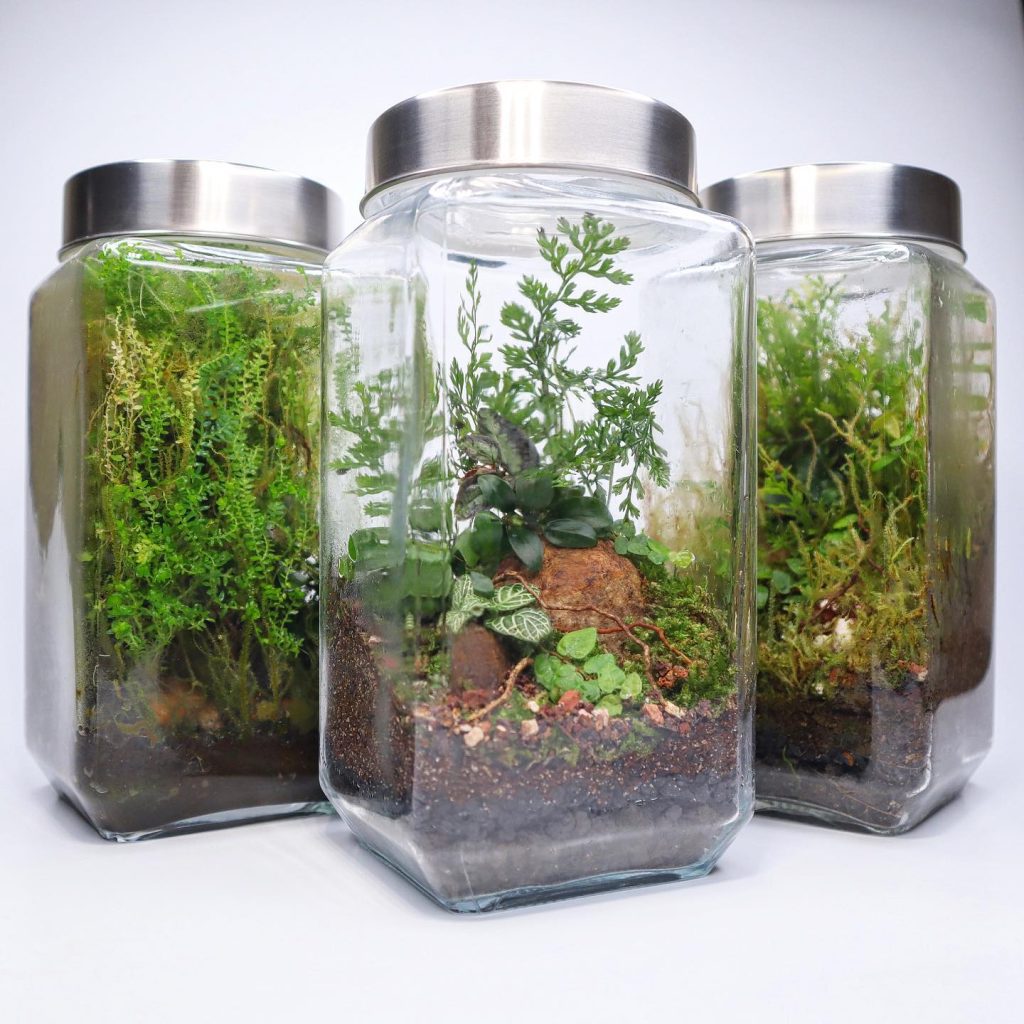Did you know that the first terrarium was created by accident in the 1840s? This fascinating fact about terrariums not only marks the beginning of a rich history but also opens a world of endless creativity right in your home. Today, DIY terrarium ideas have blossomed into a popular trend for home gardening enthusiasts and those looking to add a touch of nature to their indoor spaces. These miniature ecosystems offer a unique blend of gardening and artistic expression, all contained within a small glass world.
In this article, we dive into the enchanting realm of DIY terrariums. Whether you are a seasoned green thumb or new to the world of home gardening, our guide is packed with innovative and simple-to-follow ideas for creating your own miniature ecosystem. From selecting the right containers and plants to customizing your terrarium to match your personal style, we provide all the information you need to embark on this delightful gardening adventure. So, let’s get started and explore the myriad ways you can bring the beauty of nature into your home with these charming, self-contained gardens.



































































































































Selecting Materials for Your DIY Terrarium
Embarking on your DIY terrarium journey begins with selecting the right materials. This step is crucial as it lays the foundation for a thriving miniature ecosystem. Here, we’ll guide you through choosing the ideal terrarium containers, the best plants for terrariums, and the most suitable soil types, along with some creative decorative elements.
Terrarium Containers: The first step is to choose a container that will house your miniature garden. Terrarium containers come in various shapes and sizes, from classic glass bowls to modern geometric terrariums. Consider the size and transparency of your container – a clear, glass container allows for maximum light and visibility, essential for plant growth. Whether you opt for a closed terrarium, which is ideal for moisture-loving plants, or an open one that suits dry plants like succulents, ensure it complements your living space and meets the needs of the plants you choose.
Best Plants for Terrariums: Selecting the right plants is key to a successful terrarium. For closed terrariums, opt for humidity-loving plants like ferns, mosses, and air plants. These plants thrive in a moist environment with limited airflow. On the other hand, if you’re leaning towards an open terrarium, succulents and cacti are your best bet, as they prefer dry conditions and more air circulation. Remember, the size of the plants should be proportional to your container, and they should have similar light and moisture requirements.
Terrarium Soil Types: The right soil mix is essential for your plants’ health. Generally, a well-draining soil mix is ideal. For moisture-loving plants, a mix of peat moss, vermiculite, and perlite works well, maintaining the necessary moisture level. For succulents and cacti, a cactus potting mix, which typically contains sand for better drainage, is more suitable. Layering the bottom of the terrarium with gravel or small stones before adding soil can help improve drainage and prevent root rot.
Decorative Elements: This is where you can get creative! Add pebbles, decorative moss, miniature figures, or wood pieces to enhance the aesthetic appeal of your terrarium. These elements not only add a touch of personality but also help create a natural environment for your plants. However, be mindful not to overcrowd the space, as the main focus should remain on the health and growth of your plants.
By thoughtfully selecting your materials, you set the stage for a thriving and beautiful DIY terrarium. Remember, the beauty of a terrarium lies in its ability to reflect your personal style while creating a harmonious environment for your plants.
Creating Your Own Terrarium: A Step-by-Step Approach
Crafting a terrarium is a rewarding process that combines creativity with a touch of gardening. Follow this step-by-step guide to build your own miniature ecosystem.
Choose Your Container: Start with a clean, transparent container. The size and shape depend on the type of terrarium you’re creating and where you plan to place it.
Layer the Base: Begin with a layer of stones or pebbles at the bottom for drainage. This is especially important for closed terrariums to prevent water from pooling at the roots.
Add Activated Charcoal: A thin layer of activated charcoal over the stones will help keep the water clean and prevent mold and bacteria growth.
Layer the Soil: Depending on your plant selection, add the appropriate soil type. Use a spoon or a small tool to evenly distribute the soil, avoiding compacting it too much.
Planting: Before planting, plan the layout. Place taller plants in the back and smaller ones in front. Gently remove plants from their pots, loosen the roots, and create small wells in the soil to place them in. Press the soil around each plant to secure it.
Add Decorations: After planting, add decorative elements like stones, shells, or figurines for a personal touch.
Watering: Lightly water the terrarium, ensuring the soil is moist but not waterlogged. For closed terrariums, be sparse with water as they retain moisture effectively.
Maintenance: Place the terrarium in a spot with indirect light. Over time, monitor and prune plants to maintain shape and remove any dead or decaying matter. For closed terrariums, open the lid occasionally to let fresh air in and prevent excess condensation.
Innovative DIY Terrarium Ideas for Every Home
A terrarium is not just a miniature garden; it’s a canvas for creativity. Here are some themed terrarium ideas to inspire your next project:
Desert Theme: Create a miniature desert landscape using cacti and succulents. Add sand, rocks, and wood to mimic the arid environment. This theme is perfect for open terrariums and requires minimal maintenance.
Tropical Theme: Mimic a lush, tropical forest with moisture-loving plants like ferns and mosses. Incorporate wood bark and rich green moss for a dense, jungle-like feel. Closed terrariums work best for this theme due to their humid conditions.
Fairy Garden Concept: Transform your terrarium into a magical fairy garden with small ferns, moss, and flowering plants. Add miniature benches, houses, or figurines to create a whimsical story.
Aquatic Theme: While not housing actual water creatures, this theme uses plants like mosses and ferns to create an underwater illusion. Decorate with pebbles, seashells, and blue-tinted decorative glass to enhance the aquatic feel.
Zen Garden: For a calming effect, create a Zen garden terrarium. Use sand, smooth stones, and minimalist plants like small succulents or air plants. Include a miniature rake for rearranging the sand and practicing mindfulness.
Each of these themes allows you to express your creativity while caring for a miniature world. Remember, the best part about DIY terrariums is that there are no strict rules – feel free to mix and match elements to create a terrarium that resonates with your personal style and brings joy to your space.
Avoiding Common Pitfalls in Terrarium Making
While creating a terrarium is a fun and rewarding activity, certain common mistakes can hinder the success of your miniature garden. Here, we’ll address these issues and provide solutions to ensure your terrarium thrives.
Overwatering: One of the most frequent mistakes is overwatering. Terrariums create a humid environment, meaning they need much less water than other plants. Overwatering can lead to root rot and fungal growth. Solution: Water sparingly, ensuring the soil is slightly moist but not wet. For closed terrariums, if you see excessive condensation, leave it open for a few hours to allow some moisture to escape.
Wrong Plant Selection: Choosing plants that have different light and water needs can cause some to thrive while others suffer. Solution: Select plants with similar needs. For instance, don’t mix cacti, which prefer dry conditions, with ferns, which thrive in humidity.
Poor Placement: Placing a terrarium in direct sunlight can cause a greenhouse effect, overheating your plants. Conversely, too little light can lead to weak growth. Solution: Place your terrarium in a location with indirect, natural light. Monitor the light throughout the day to ensure it’s not too intense or too scarce.
Conclusion
Creating a DIY terrarium is an enriching experience that combines the beauty of nature with personal creativity. It’s not only a unique decorative element for your home but also a delightful way to engage with the natural world on a miniature scale. From selecting the perfect glass container and plants to crafting a tiny ecosystem, each step in the terrarium-making process offers a chance to learn, experiment, and express yourself.
Now that you’re equipped with the knowledge and inspiration to start your own terrarium project, we encourage you to dive in and enjoy the process. Remember, each terrarium is a living piece of art, unique in its way. We’d love to see what you create! Share your experiences and your newly crafted miniature gardens with us. Whether it’s a lush tropical paradise, a serene desert landscape, or a whimsical fairy garden, your DIY terrarium is a testament to your creativity and care for the natural world. Happy terrarium making!








